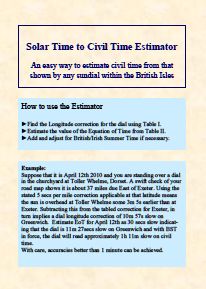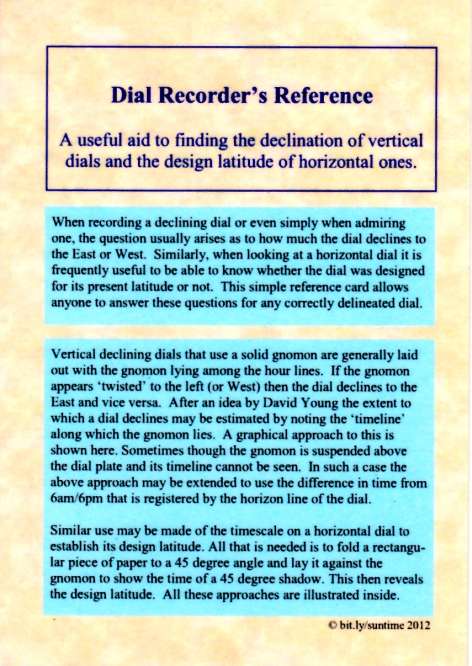
The Solar Time to Civil Time Estimator© and now
The Recorder's Reference©
1. Solar Time to Civil Time Estimator© (Scroll down for the Recorder's Reference)
The Estimator is a useful reference card that allows anyone to check the accuracy of any sundial in the British Isles by converting the dial's displayed solar time to civil time. It provides the means to make approximate estimates of both the Longitude and Equation of Time corrections. If care is taken the final estimate of dial time correction can be within one minute and it is often within 30 seconds of the fully calculated value.

This little folded card was made available by the British Sundial Society to delegates to its Annual Conference in early 2010. A few of these versions, professionally printed on card as per the image above are still available at modest cost. Buy now while stocks last. Select the applicable price according to where you want your estimator posted. NB: The Equation of Time Corrections are specifically calculated for 2010-2011 but they can nevertheless still be used beyond that period with only a few seconds difference and in any case the corrections return to their original accuracy every four years because of the leap year cycle.
|
|
||
|
|
How does it work?
There are three or four aspects that need to be considered when converting the time shown on a sundial in the British Isles to Civil Time.
1. The fact that the dial being viewed will not generally
be sited on the Greenwich Meridian from which all UK, Irish and Crown Island
Dependency civil time is
reckoned.
2. The fact that the earth's axial tilt and its elliptical orbit around
the sun generate
a varying time difference compared to the steady time of a clock. This
correction is
called the Equation of Time.
3. The operation of British (or Irish) summer time
from the last Sunday in March until
the
last Sunday in October.
The Estimator provides a table to show the amounts by which a dial in any one of several cities of the British Isles is slow or fast on Greenwich. These cities and towns are grouped in bands of roughly the same latitude so that a common correction can be provided for each of these bands according to how much the actual dial location is due East or West of one of these cities. It is best if you can choose a nearby town and use a road map to estimate the miles East or West of the town the dial is. This distance should be measured 'horizontally' in an E-W direction, not directly as the crow flies and not as a road mileage distance between the two places. That then can be multiplied by the correction per mile quoted in the Estimator table to get an estimate of the longitude correction that needs to be applied. Dials situated West of the chosen reference town will be slower on Greenwich than the town itself and vice versa if the town is East of the reference town.
In a second table the Estimator lists the values of the Equation of Time correction to the nearest minute for those dates upon which it first achieves the integer value shown. Thus the times shown for specific dates will be within 30 seconds. Ordinary (linear) interpolation between dates will usually yield a value that is close to the same sort of accuracy. Care should be taken around dates where the value of the Equation of Time is changing direction since ordinary interpolation might not be as accurate as taking the turning point value. The values were calculated for 2010. They do change slightly from year to year during the leap year cycle but the differences are small and in any case they come back every four years.
Finally, if summer time is in force then Clocks will be faster than a dial by a further hour.
The estimates made using the tables in the Estimator will ordinarily yield total corrections that are within a minute and often within 30 seconds of the fully computed value.
The Recorder's Reference is a little folded reference card (very roughly 4ins x 3ins - the same size as the Estimator above) that provides anyone interested in dialling with a way to estimate by how much a non-direct-south vertical dial declines and also to find the design latitude for any horizontal dial. The operation of the card for dial declination estimations was explained in a series of slides given by the author at a BSS meeting in Newbury in 2005.
A PDF of that slide set (5MB) may be seen and downloaded here.

|
|
NB: The design of the Estimator is
copyright © P. Powers, 2010-2017 and that of The Dial Recorder's Reference is copyright ©
P. Powers, 2012-2018 .
Private and non-commercial use of the Estimator and the Recorder's Reference is
permitted.